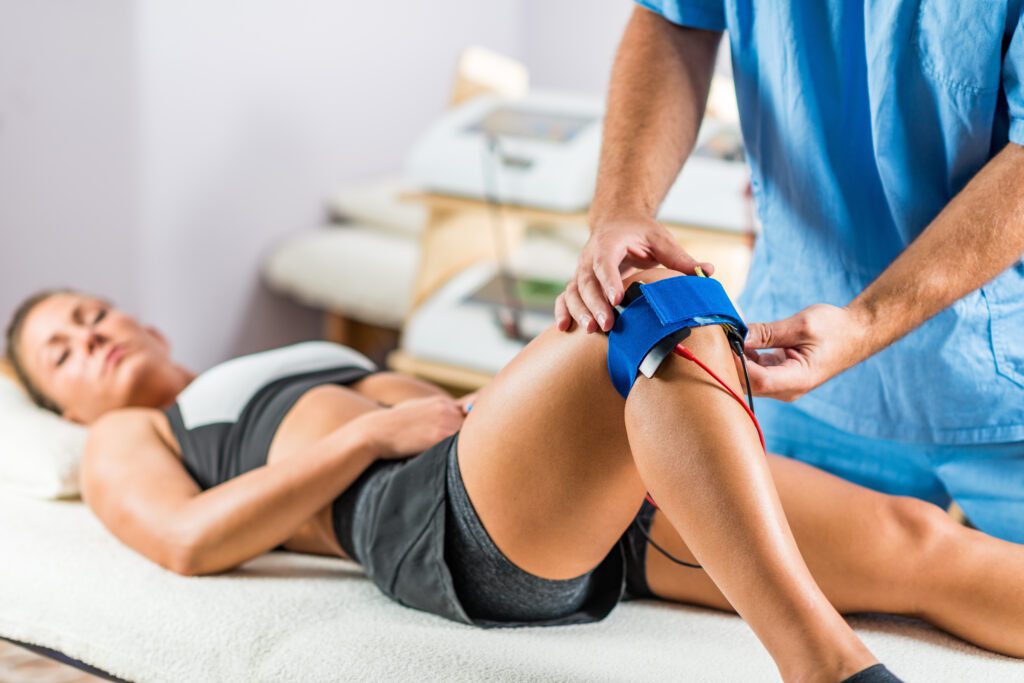Introduction
Our physical well-being holds paramount importance in the journey toward leading a fulfilling and vibrant life. Among the many approaches to achieving optimal physical health, fit physical therapy emerges as a powerful and transformative method to improve our physical condition and elevate our overall quality of life. This comprehensive and highly informative article delves deep into physical therapy, exploring its definition, benefits, and pivotal role as the key to unlocking a healthier and stronger body.

Understanding Fit Physical Therapy
Definition and Goals
Physical therapy, also known as fitness-based or sports-specific physical therapy, is an innovative approach that seamlessly integrates the principles of traditional physical therapy with fitness and exercise. The primary goal of fit physical therapy is to optimize strength, flexibility, endurance, and overall physical performance. Moreover, it aims to prevent injuries, expedite recovery after an injury, and maximize the body’s functioning to support an active and dynamic lifestyle.
Benefits of Healthy Physical Therapy
The benefits of physical therapy are profound and far-reaching. Beyond physical enhancements, it empowers individuals with injury prevention strategies, rehabilitates the body after injuries, enhances athletic performance, and addresses common fitness challenges such as chronic pain, mobility issues, and muscular imbalances. Suitable physiotherapy transcends the boundaries of mere treatment; it delves into the root causes, fostering lasting improvements in physical well-being.
Target Audience for Healthful Physical Therapy
While physical therapy is often associated with athletes, it is essential to recognize that its benefits extend far beyond sports. This approach caters to anyone seeking to improve their fitness level, from sports enthusiasts aspiring to excel in their disciplines to individuals yearning for a more active, pain-free, and invigorated lifestyle. Appropriate physiotherapy embraces inclusivity, adapting to diverse needs and fitness goals.
The Role of Fit Physical Therapy in Injury Prevention
Identifying Risk Factors
One of the primary roles of physical therapy is identifying potential risk factors for injuries. Physical therapists possess the expertise to conduct thorough assessments that analyze an individual’s biomechanics, movement patterns, and muscle imbalances. By identifying weaknesses and imbalances, they can pinpoint areas of vulnerability that may lead to injuries during physical activities.
Customized Exercise Programs
Once risk factors are identified, physical therapists design personalized exercise programs tailored to individual needs. These customized programs aim to target and strengthen specific areas of concern, ultimately reducing the likelihood of injuries.
Strengthening and Conditioning Techniques
Physical therapy emphasizes the importance of strengthening and conditioning to improve physical performance and prevent injuries. Incorporating resistance training, functional exercises, and core strengthening, this approach focuses on enhancing the body’s resilience and capacity to withstand physical demands.
Education on Proper Movement Mechanics
In addition to exercise programs, physical therapy that is suitable provides education on proper movement mechanics and body alignment. By instilling correct movement patterns, physical therapists help minimize the risk of injury during daily activities and exercise routines.
Holistic Approach to Injury Prevention
Physical therapy takes a holistic approach to injury prevention, considering factors such as nutrition, sleep, and lifestyle choices. This comprehensive approach aims to optimize overall well-being and promote a healthier, injury-resistant body.
Addressing Specific Populations
Fit physical therapists tailor their injury prevention strategies to suit specific populations, such as young athletes, seniors, or individuals with specific health conditions. This personalized approach ensures individuals receive targeted care and guidance to prevent injuries effectively.
Fit Physical Therapy for Rehabilitation and Recovery

Post-Injury Therapy
When injuries occur, physical therapy plays a crucial role in rehabilitation. Physical therapists collaborate with patients to develop comprehensive post-injury therapy plans to restore function, mobility, and strength.
Multimodal Approach to Recovery
Physical therapy embraces a multimodal approach to recovery, incorporating various therapeutic techniques such as manual therapy, ultrasound, heat, and ice application. This comprehensive approach accelerates healing, reduces pain, and improves rehabilitation.
Preventing Secondary Injuries
Beyond addressing the primary injury, exercise physical therapy also focuses on preventing secondary injuries that may arise due to compensatory movements or muscle imbalances during recovery.
Psychological Support and Motivation
Recovering from an injury can be mentally challenging. Fit physical therapists recognize the importance of providing psychological support and motivation to help individuals stay positive, focused, and committed to their recovery journey.
Empowering Patients with Home Exercises
To complement in-clinic sessions, fit physical therapists empower patients with specific home exercises to continue their progress and maintain momentum outside the therapy setting. These exercises are carefully designed to support rehabilitation and promote long-term recovery.
Ensuring a Safe Return to Activity
Fit physical therapists prioritize a safe and gradual return to activity after an injury. This cautious approach ensures that the body heals properly and reduces the risk of re-injury, giving individuals the confidence to resume their daily activities and exercises.
Monitoring Progress and Adjusting Treatment
During rehabilitation, fit physical therapists continuously monitor patients’ progress and make necessary adjustments to the treatment plan. This personalized attention ensures that each individual receives the optimal care and support needed for a successful recovery.
Holistic Approach to Rehabilitation
Physical therapy adopts a holistic approach to rehabilitation, considering not only the physical aspects of recovery but also patients’ emotional and mental well-being. This approach supports overall healing and enhances the patient’s well-being during their recovery journey.
Enhancing Athletic Performance through Fit Physical Therapy
Sports-Specific Training
For athletes seeking to optimize their performance, physical therapy offers sports-specific training programs tailored to the unique demands of each sport. These programs enhance an athlete’s strength, agility, and overall performance.
Enhanced Sports Conditioning
Incorporating fit physical therapy into an athlete’s training regimen enhances their sports conditioning, enabling them to perform at their peak during competitions and training sessions. This improved conditioning improves endurance, reduces fatigue, and enhances overall athletic ability.
Injury Prevention for Athletes
Injuries are common in sports, and physical therapy provides athletes with strategies to prevent injuries. By addressing potential risk factors, physical therapists help athletes maintain their training and performance consistency, minimizing the likelihood of injuries.
Customized Training Plans for Athletes
Fit physical therapists work closely with athletes to design customized training plans considering their specific goals, strengths, and weaknesses. These plans maximize an athlete’s potential and facilitate continuous growth and improvement.
Sports-Specific Injury Management
In the unfortunate event of an athletic injury, fit physical therapists employ specialized approaches to manage sports-related injuries. Their expertise in sports-specific injury management aims to promote faster recovery and an early return to training and competition.
Nutrition and Recovery
Fit physical therapy professionals often collaborate with sports nutritionists to optimize an athlete’s nutrition for enhanced recovery and performance. Proper nutrition supports an athlete’s training, performance, and overall well-being.
Periodization and Training Cycles
Physical therapy incorporates periodization and training cycles into an athlete’s regimen. This strategic approach involves planning training phases to optimize athletes’ performance throughout their competitive season while minimizing the risk of overuse injuries.
Mind-Body Connection in Sports Performance
Fit physical therapy recognizes the importance of the mind-body connection in sports performance and incorporates strategies to enhance mental focus and resilience. A solid mental game complements an athlete’s physical abilities, contributing to better performance under pressure.
A Lifelong Athletic Journey
Physical therapy supports athletes throughout their athletic journey, from young athletes in development programs to seasoned professionals in the twilight of their careers. This comprehensive support fosters an enduring passion for sports and fitness and promotes a lifelong commitment to physical well-being.
Inclusive Athletic Development
Fit physical therapy advocates for inclusive athletic development, encouraging athletes of all ages and abilities to pursue their passion for sports and fitness. By tailoring training programs to suit individual needs, physical therapy for the fit promotes diversity and inclusivity in the athletic community.
Addressing Common Fitness Challenges with Fit Physical Therapy

Chronic Pain Management
Chronic pain can significantly impact an individual’s quality of life, hindering their ability to participate in daily activities and exercises. Physical therapy offers specialized approaches to manage and alleviate chronic pain through targeted exercises, manual therapy, and lifestyle modifications.
Enhancing Mobility and Flexibility
Physical therapy strongly emphasizes mobility and flexibility exercises, which are essential for maintaining joint health and allowing individuals to move freely and comfortably.
Correcting Muscular Imbalances
Muscular imbalances can lead to various health issues and injuries. Suitable physical therapy addresses these imbalances through targeted exercises and stretching routines, promoting muscular symmetry and stability.
Improving Balance and Coordination
Incorporating exercises aimed at enhancing balance and coordination, Fit physical therapy effectively mitigates the likelihood of falls and injuries, mainly targeting the well-being of older adults.
Promoting Proper Posture and Alignment
Fit physical therapists educate individuals on proper posture and body alignment, helping prevent musculoskeletal issues caused by poor postural habits.
Cardiovascular Health and Endurance
Fit physical therapy emphasizes cardiovascular exercises and endurance training to enhance heart health and overall physical fitness.
Injury Prevention for Everyday Activities
In addition to addressing sports-related injuries, fit physical therapy provides valuable injury prevention strategies for everyday activities. By promoting safe movements in tasks such as lifting, carrying, and bending, fit physical therapy ensures that individuals can engage in their daily routines without fear of injury.
Supporting Aging Gracefully
Fit physical therapy supports individuals as they age, assisting in maintaining their physical function and independence. By prioritizing mobility, flexibility, and strength, fit physical therapy fosters a sense of vitality and autonomy in older adults.
Fitness and Pregnancy
Fit physical therapy offers safe and effective exercises for expectant mothers, promoting physical well-being and supporting a healthy pregnancy journey. By addressing the unique physical changes that occur during pregnancy, fit physical therapists assist in maintaining fitness levels and managing common pregnancy discomforts.
Postnatal Recovery and Rehabilitation
Post-pregnancy, fit physical therapy aids in the postnatal recovery process, addressing changes in the body and helping mothers regain their strength and fitness.
Integrating Fit Physical Therapy with Other Fitness Practices

Yoga and Pilates Integration
Integrating fit physical therapy with practices like yoga and Pilates enhances flexibility, balance, and mind-body awareness, supporting overall well-being.
Functional Movement Integration
Fit physical therapy emphasizes functional movements that mimic daily activities, optimizing an individual’s ability to perform everyday tasks quickly and confidently.
Strength Training and Fit Physical Therapy
Integrating strength training with fit physical therapy improves muscular strength and endurance, enhancing physical performance and overall fitness.
Cross-Training and Fitness Diversity
Fit physical therapy encourages cross-training and diverse fitness practices to promote a well-rounded and resilient body. Individuals can challenge different muscle groups and reduce the risk of overuse injuries by engaging in various activities.
Mindfulness and Fitness
In perfect harmony with fit physical therapy, mindfulness practices encompassing meditation and deep breathing synergistically contribute to stress reduction and the holistic enhancement of overall well-being. By incorporating mindfulness techniques, individuals can cultivate a sense of calm and focus during their fitness journey.
The Role of Nutrition in Fitness
Fit physical therapy professionals often collaborate with nutritionists to ensure that an individual’s dietary choices complement their fitness goals, promoting optimal health and performance. Proper nutrition is essential for supporting physical activity and aiding in recovery.
The Science Behind Fit Physical Therapy
Understanding the Human Body
Fit physical therapy rests upon a solid groundwork of anatomical and physiological expertise, forming the cornerstone of its effective practice. Physical therapists possess a comprehensive understanding of how the human body functions and how it responds to exercise and therapeutic interventions.
Biomechanics and Movement Analysis
Physical therapists analyze an individual’s biomechanics and movement patterns to identify deviations or imbalances contributing to injury or hindering optimal performance. This thorough analysis guides the development of personalized treatment plans.
Evidence-Based Practices in Fit Physical Therapy
Fit physical therapy is grounded in evidence-based practices, meaning that the treatments and exercises utilized are supported by scientific research and proven effective. This evidence-based approach ensures that patients receive the highest standard of care.
Patient-Centered Approach
Fit physical therapy is patient-centered, with an unwavering focus on each individual’s unique needs, goals, and limitations. By customizing treatments to suit the patient, fit physical therapists optimize the therapy experience and improve outcomes.
Continuing Education and Advancements
Fit physical therapists prioritize continuing education and stay updated on the latest research and advancements in the field. This commitment ensures that patients receive the most effective and cutting-edge therapies available.
Choosing the Right Fit Physical Therapist

Credentials and Experience
When selecting a fit physical therapist, one must consider their credentials, certifications, and relevant experience in sports and fitness-related physical therapy. A well-qualified therapist brings expertise and proficiency to the therapy process.
Patient Reviews and Testimonials
Reading reviews and testimonials from previous patients provides valuable insights into a physical therapist’s effectiveness and patient satisfaction. Positive feedback and success stories indicate a therapist’s skill and expertise.
Communication and Empathy
A successful fit physical therapist communicates effectively, listens attentively, and demonstrates empathy, creating a positive and supportive therapy environment. Effective communication fosters trust and addresses the patient’s needs and concerns.
Collaboration and Personal Connection
Fit physical therapy is most effective when there is a collaborative partnership between the patient and the physical therapist. A good-fit physical therapist builds a personal connection with their patients, fostering a sense of trust and motivation throughout the therapy journey.
Holistic Approach to Healthcare
An ideal fit physical therapist understands the importance of considering the whole person in their care. They recognize that physical health is interconnected with mental, emotional, and social well-being and incorporate this holistic perspective into their treatments.
Patient Education and Empowerment
A knowledgeable fit physical therapist educates their patients about their condition, treatment options, and strategies for self-care. By empowering patients with information, individuals become active participants in their therapy and recovery.
Preparing for Fit Physical Therapy Sessions
Setting Realistic Goals
Before embarking on physical therapy, setting specific and achievable goals is crucial. These goals serve as a roadmap, guiding the therapy journey and providing motivation for progress.
Understanding the Process
Familiarizing oneself with the physical therapy process helps alleviate any uncertainties or anxieties. Understanding what to expect during sessions and the overall treatment plan enhances the patient’s comfort and confidence in the therapy.
Maintaining a Positive Mindset
Approaching fit physical therapy with a positive mindset is essential for progress and success. A positive attitude fosters resilience and the willingness to embrace challenges and overcome obstacles during therapy.
Compliance and Consistency
Adhering to the recommended exercise routines and treatment plans is crucial for successful outcomes. Consistent participation and compliance with the therapist’s instructions facilitate progress and yield long-term benefits.
Patience and Trust in the Process
Physical therapy is a journey, and progress may not always be linear. Patience and trust in the process are vital to staying committed and persevering through the ups and downs of the therapy journey.
Success Stories: Real-Life Transformations

Case Studies
Real-life case studies provide concrete evidence of the positive impact of physical therapy on individuals’ lives. These success stories inspire and demonstrate the potential for transformation that fit physical therapy offers.
Inspiring Testimonials
Reading inspiring testimonials from individuals who have experienced significant improvements through physical therapy for fitness is a testament to its efficacy and motivates others to pursue their fitness goals.
Enhanced Quality of Life
Physical therapy enhances physical performance and improves overall quality of life. Stories of individuals regaining mobility, becoming pain-free, and reclaiming their active lifestyle inspire hope and determination.
Empowerment and Self-Confidence
Fit physical therapy fosters a sense of empowerment and self-confidence in individuals, knowing they have the tools and support to take charge of their health and well-being. This newfound self-confidence extends beyond therapy, positively impacting their lives.
Long-Term Wellness and Prevention
The success stories of individuals who maintain their fitness and well-being long after their physical therapy that fits journey showcase the importance of prevention and self-care. By integrating the principles of fit physical therapy into their daily routines, individuals can sustain their health and prevent future injuries.
Future Trends in Physical Therapy
Advancements in Technology
The ever-evolving landscape of technology remains a driving force in propelling the progress of fit physical therapy, exerting a significant and indispensable influence on its continuous advancement. Innovations such as wearable devices, virtual reality-based therapies, and mobile applications enhance the patient experience and expand therapeutic possibilities.
Personalized Therapy Programs
The future of physical therapy lies in highly personalized therapy programs that cater to each individual’s unique needs, goals, and preferences. Advanced assessment tools and data-driven approaches enable therapists to tailor treatments more precisely.
Integrative Healthcare Approaches
Fit physical therapy is increasingly integrated into broader healthcare practices. Recognizing the interconnectedness of physical health with mental, emotional, and social well-being is leading to more comprehensive and holistic approaches to healthcare.
Preventive Wellness Strategies
Physical therapy is shifting towards a more preventive focus, promoting wellness and fitness as preventive measures to reduce the risk of injuries and chronic conditions. By proactively addressing potential issues, fit physical therapy improves long-term health outcomes.
Collaboration and Interdisciplinary Care
Collaboration between fit physical therapists and other healthcare professionals, such as nutritionists, strength coaches, and mental health specialists, is becoming more prevalent to provide comprehensive patient care. This collaborative approach ensures that patients receive a well-rounded and integrated healthcare experience.
Telehealth and Virtual Therapy
Telehealth and virtual therapy options are gaining popularity, enabling individuals to access physical therapy services remotely and conveniently. The widened accessibility not only extends the grasp of physical therapy but also renders it remarkably convenient for individuals leading hectic lives or facing constraints in accessing in-person sessions.
Research in Sports and Fitness Performance
Ongoing research in sports science and fitness performance is shaping the future of fit physical therapy, optimizing training techniques and injury prevention strategies. As research discovers new insights, physical therapy will evolve to offer more effective and innovative approaches to improving physical health and performance.
Expanding Access to Proper Physical Therapy
Efforts to expand access to physical therapy services, particularly in underserved communities, are a priority in promoting health equity and inclusivity. As awareness of the benefits of fit physical therapy grows, initiatives to improve access and affordability will help more individuals benefit from this transformative approach to physical well-being.
Common Misconceptions about Correct Physical Therapy

Myth-busting the Stereotypes
Addressing common myths and misconceptions helps promote a more accurate understanding of fit physical therapy and its role in promoting physical health. By debunking misinformation, physical therapy gains credibility and encourages more individuals to explore its potential benefits.
Evidence-Based Clarifications
Dispelling misinformation by providing evidence-based information enhances public awareness and reinforces the credibility of physical therapy as a reliable and effective healthcare approach. Providing factual evidence supports the legitimacy of fit physical therapy as a viable option for improving physical health.
Educating the Public
Promoting awareness and understanding of fit physical therapy’s benefits and limitations helps individuals make informed decisions about their healthcare options. By educating the public, physical therapy can overcome misconceptions and inspire individuals to consider it a valuable component of their health and wellness journey.
Recognizing Individuality in Therapy Outcomes
Addressing misconceptions about fit physical therapy outcomes helps individuals understand that therapy results may vary based on age, health status, and compliance. Recognizing individuality in therapy outcomes fosters realistic expectations and encourages individuals to focus on their unique progress.
Promoting Inclusivity in Fitness
Dispelling misconceptions about fit physical therapy being exclusively for athletes helps foster inclusivity in fitness, encouraging individuals from all walks of life to prioritize their physical health. Regardless of age, capabilities, or fitness levels, fit physical therapy extends its accessible and advantageous benefits to all individuals, promoting overall well-being and vitality.
Conclusion
In conclusion, fit physical therapy emerges as a beacon of hope, guiding individuals toward a healthier, more vital, and more vibrant life. It transcends the boundaries of traditional physical therapy by integrating fitness principles, preventive strategies, and evidence-based practices. Physical therapy empowers individuals to take charge of their health, prevent injuries, recover from setbacks, and enhance their physical performance. As the future trends in fit physical therapy evolve, personalized, interdisciplinary, and holistic approaches will undoubtedly pave the way for a new era of preventive wellness and integrative healthcare. Embrace the potential of fit physical therapy, and embark on a transformative journey towards a healthier and stronger body that supports your aspirations and enriches your life.
FAQs
Q. How does audio-visual technology enhance the entertainment industry?
A. Audio visual technology enhances the entertainment industry by providing high-resolution displays, immersive audio experiences, and technologies like virtual and augmented reality that transport viewers into virtual worlds.
Q. What are some examples of audio-visual technology in healthcare?
A. Examples include medical imaging systems such as X-rays and MRIs, surgical navigation systems, telemedicine platforms for remote consultations, and patient monitoring devices.
Q. How does audio-visual technology benefit businesses?
A.Audio-visual technology helps businesses communicate effectively through video conferencing, engage customers through digital signage and video walls, and provide immersive training experiences for employees.
Q. What are some future trends in audio-visual technology?
A. Future trends include advancements in display technologies like 8K resolution, extended reality (VR/AR/MR), AI and ML integration, IoT connectivity, and interactive and immersive experiences.
Q. Where can I access audio-visual technology products and services?A. There are various retailers, online marketplaces, and specialized audio-visual technology providers where you can find various products and services to meet your audio-visual needs.








